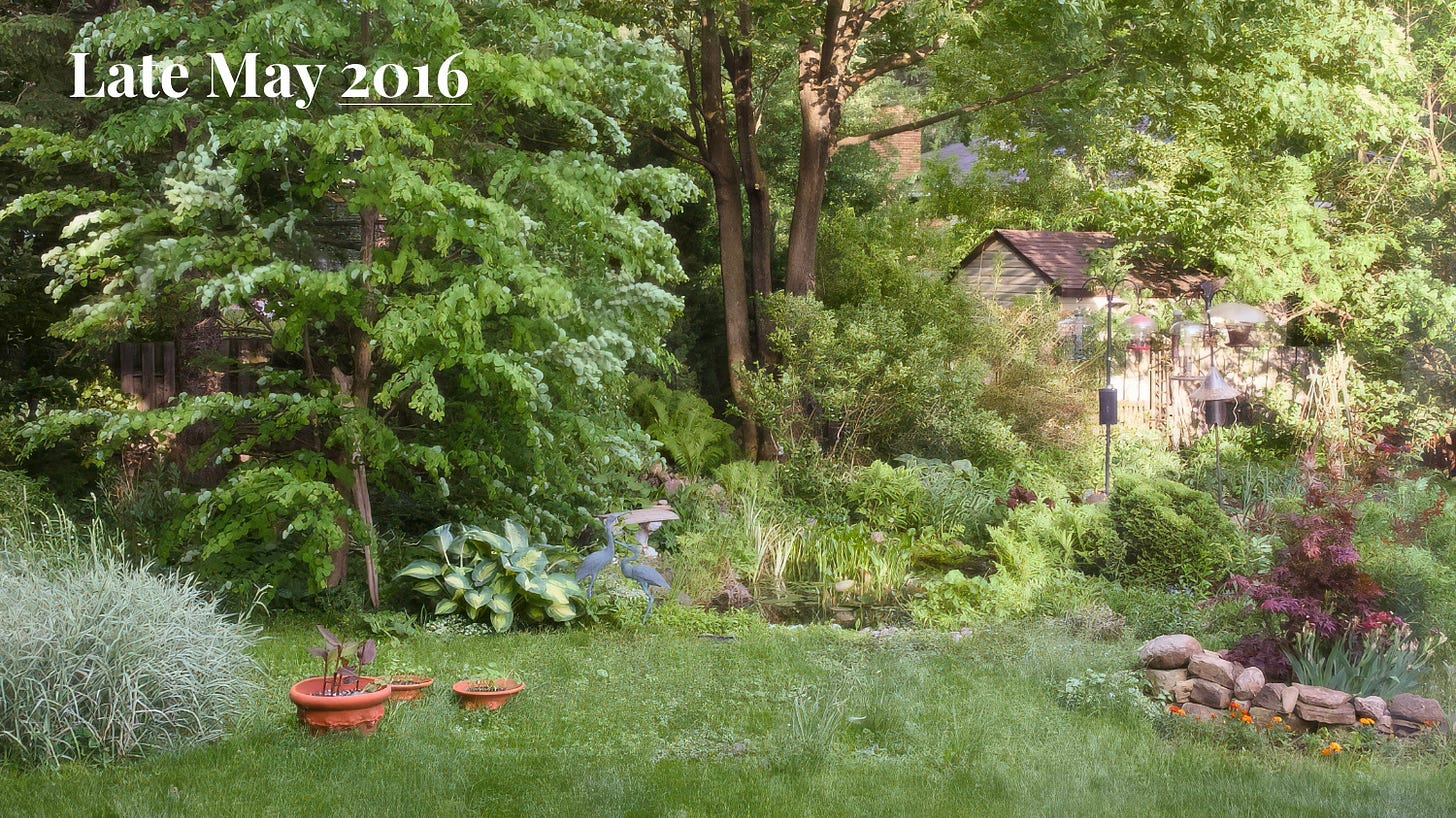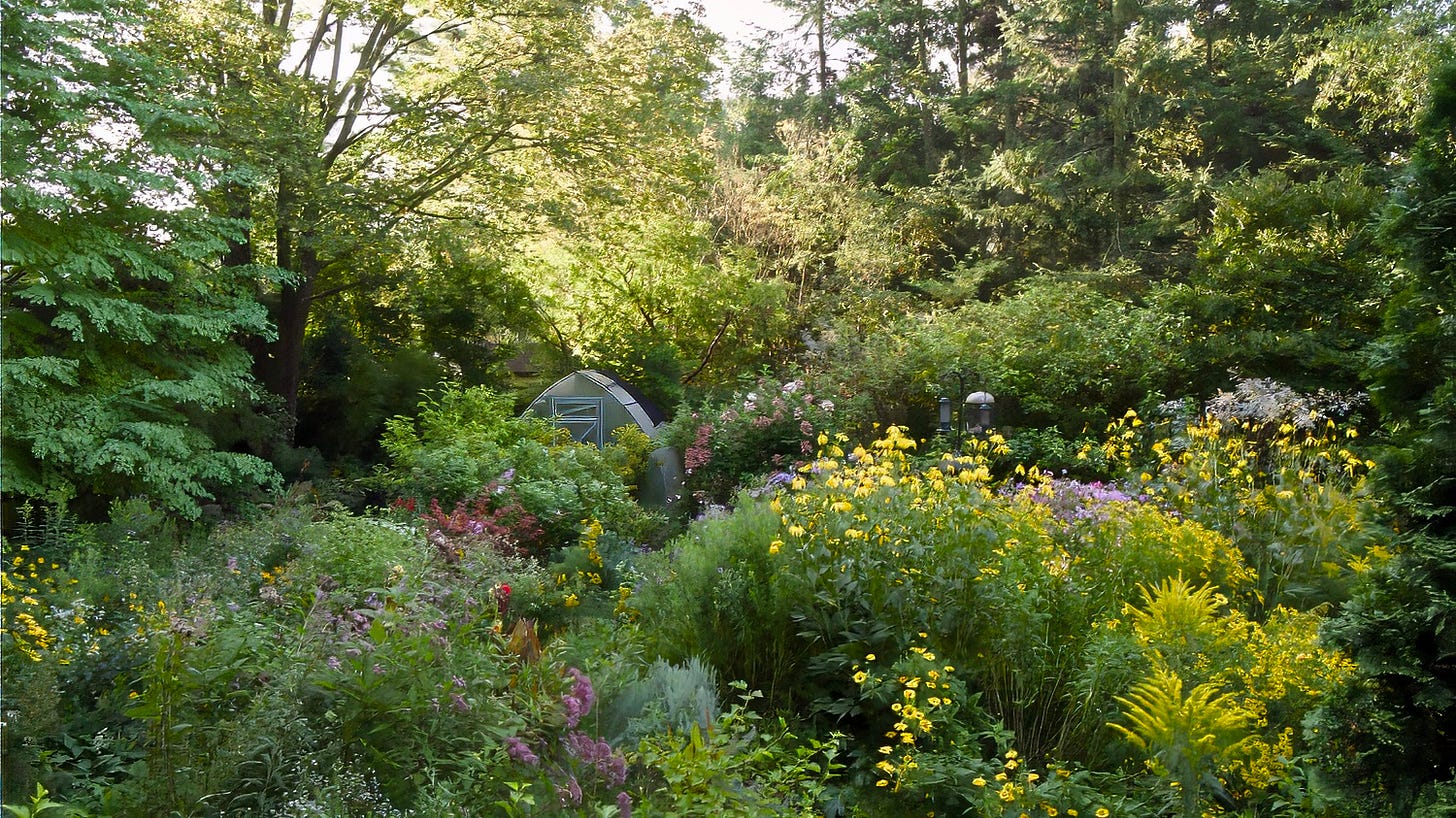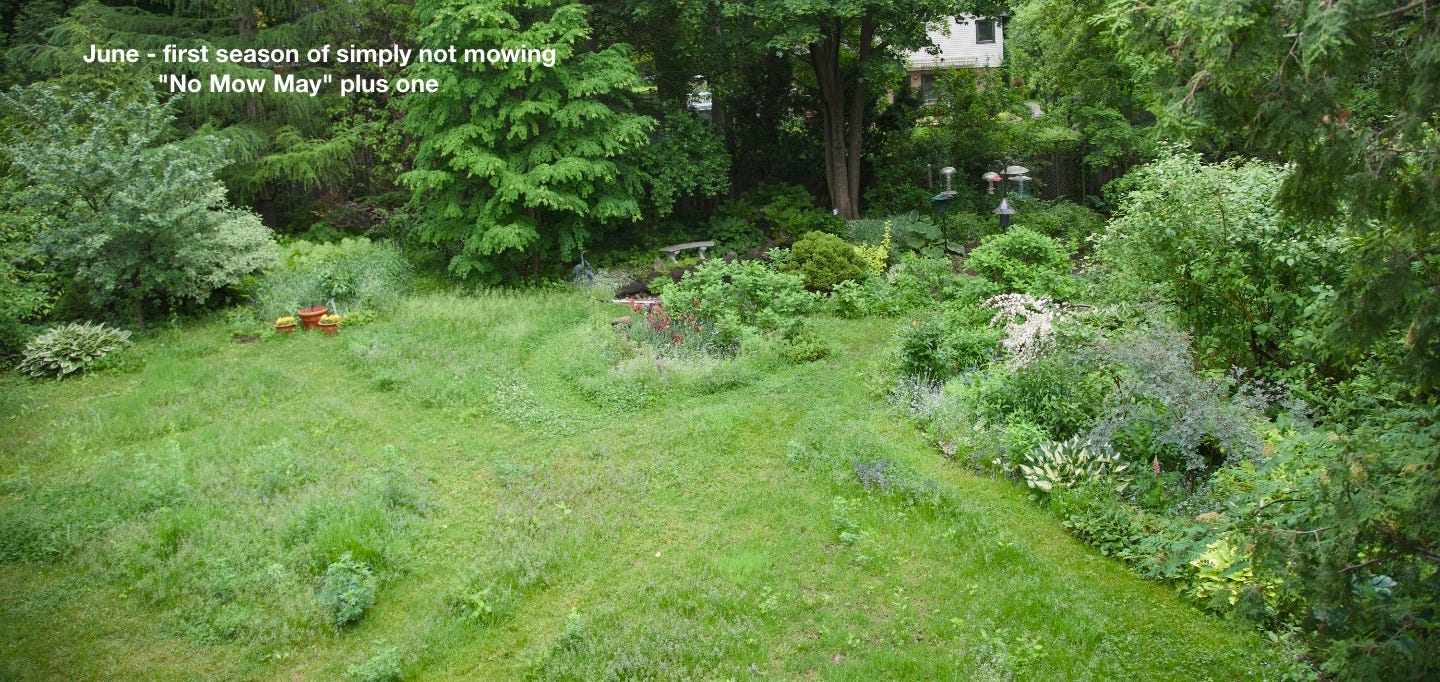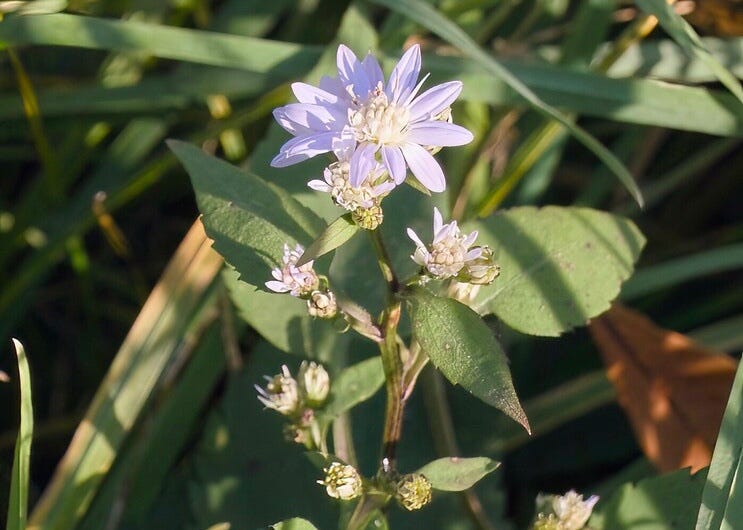Our small town has an environment committee where members of the town council (we only have six to choose from, it’s a very small town) meet with “enlightened” residents to plan and discuss matters of a green nature. A few days ago the possibility of transforming at least some parts of too closely mown park grass into a healthier meadow was broached. Mental seeds have been sown and we will see what transpires, but it minded me to write a few words on how garden lawns, or corners thereof, might be managed with similar intention. I know the idea has traction from conversations I have with neighbours - often the missing component is the how rather than they why of making the changes.
But Rome wasn’t made in a day, and there is more to this than just leaving the mower in the shed and letting nature take its course. If you want to move from lawn to meadow how can the transition be made relatively easily?
These pictures show a part of my own garden. The first picture was taken this week in 2016 when there was lawn there and the second was taken two days ago. Later in the summer the plants will be at least twice as tall and covered with flowers (there is a photo of that further down). We no longer have any lawn, and that’s by design. There is no need for you to go that far - maybe just select an area and see how it goes.
The internet is replete with recipes for lawn replacement and some of the methods are effective. However, conversations that I have had with people interested in replicating our changes tell me that for most of them, good enough often beats perfection - especially when they want reasonably rapid results without devoting too many hours to the job. Remember too, that native plant gardening is as much for the benefit of birds and butterflies as it is for people, and that wildlife doesn’t care about the look of the world, so long as they can make a decent living there. Not only do suburban meadows provide habitat for many species, but they also support soil health, improve air quality, and reduce the use of fertilizers and pesticides
That lawn you have at the moment is almost certainly a mixture of native and non-native grasses that are thuggish and want to outcompete anything you plant amongst them. The companies who prepare the lawn seed mixes or grow the sod you lay choose grasses that are strong and grow well because that’s what their customers expect. Ideally, to start the change to meadow, you might strip off the turf but that, speaking from hard won experience, is a rather strenuous task. You can hire a powered sod cutter, or do the job manually with a grub hoe which is basically an adze with an 8-inch-wide blade that cuts through roots. A tug on the handle rips turf out of the ground. Take short swings, just hard enough to penetrate the root layer—a couple of inches deep, at most. Walk forward as you work so the cut pieces of sod don’t cover up the grass to be removed.
Alternatively, mow the grass as low as you can (really scalp it) and then lightly till the soil, removing grass roots with care as you go. I would caution though that hand tilling is also quite hard work so if you have, or can rent, a decent power tiller that will do the job quite well, and a lot more rapidly.
A second option that you will often read about is “lasagna gardening” where you lay down cardboard or layers of newspaper covered with thick mulch over your lawn for several months until the grass dies off and the cardboard decomposes. Effective, but it takes quite a time.
Lastly, try “solarization” by which you water the grass well and then cover the area with clear plastic sheeting for 4-6 weeks during hot sunny weather, which will very effectively kill off the existing grass by heat. You do have the problem then of responsibly disposing of that plastic sheet unless you can find another use for it. After that, simply rake the soil level to create an even surface where seeds can germinate. Any remaining bits of now well cooked grass can go to the compost heap.
Now you can think about the plants you want. Various options here - while the lawn was being scalped, tilled or burnt off you might have been raising plants from seeds in a greenhouse or buying plugs from a specialist nursery. Plugs are by far the fastest to establish, but also the most expensive. Alternatively broadcast a native plant mix over your prepared area … noting that while many native seed mixes tailored for meadows are available on the market, they do not necessarily contain species suitable for your region. I have seen a mix sold here in Montreal that contained seeds of plants more suitable to California! Perhaps create your own mix based on local flora recommendations from local conservation organizations or wide reading. Use a mix of annuals and perennials so you have more flowers in your first season which is encouraging. Spread the seeds evenly across the exposed soil, lightly cover with soil but only lightly, they don’t want to be too deep. Tamp them down to remove air pockets and hide them from seed eating creatures and water gently. The best times to sow the seeds are spring or fall - hot, dry summers make germination success more problematic. Personally, I would opt for fall sowing as a number of species of plants that do well in the north require cold stratification for maximum germination.
Make sure that seedlings receive adequate moisture until they are established (usually during their first growing season). Keep an eye on your new meadow for invasive weeds that may compete with native species - there is a high chance that things like dandelions and plantain will have left viable root fragments in the soil and they will re-sprout given a chance. Hand-pulling will keep such plants under control without harming beneficial species.
Lastly, be patient. Your meadow is going to take several growing seasons to establish itself fully. That’s nature, and is also why you may want to plant some plugs to get ahead of the game a bit. the patience pays off though. This is what the garden shown above will look like in August … so much better than a lawn and full of birds and butterflies but it took a few years to get to this stage.
The Middle Way …
“But it’s too much work to replace the grass” you might be saying. “I’ll settle for good enough any time.”
OK, I can help there too. It involves compromises but it’s still way better than a traditional lawn. Simply try this - set your mower as high as you possibly can. That’s usually about four inches on most machines but set as high as you are able. This has several advantages - firstly you still have a “lawn” but the longer grass will be more drought resistant, will develop deeper roots and yet will not be so long that it shades any volunteer native plant seeds that arrive or which you deliberately oversow with, and allows those that reach the soil to germinate. Gradually new species of meadow plants will find their way to you or you can introduce them by planting seedling plugs.
Going for the Middle Way you still need to mow, but do it in a way that allows the meadow plants to grow and set seed. Supposedly, this means mimicing the actions of grazing animals. In the first year cut every couple of months to no lower than four inches. In subsequent seasons, usually just a cut in spring and again in mid fall is advised – remembering never to cut too short and be careful to go around tall clumps of perennials like Asters and Rudbeckia etc. Some authorities suggest that an August cut might also be considered, and that one can be a bit lower to expose areas of bare soil in order to help flower seeds can make contact and germinate. Up to you, you need to experiment and work with the soil and climate unique to your region.
It’s a bit more work but you will find that a string trimmer gives you better control when you cut. After these two annual cuts, it is important to rake off the cuttings and compost them. Why? Because most wild/native species do not need the soil to be too nutrient rich as it encourages green growth at the expense of flowers.
Or, you can opt for the sort of garden that I have where there is no grass at all. I love it, but I think most people will want to opt for a shorter flowery meadow at least somewhere. Either way the wildlife will thank you.
Species to start with? Rudbeckia, Echinacea (coneflowers), Asters (many varied species - have a selection), Golden Rod and so on. Remember that other seeds will arrive on the feet of birds etc and over the years your variety will enrich itself naturally. The mix of plants in the photo at the top of the page contains over 50 different species after only a few years and we certainly didn’t plant that many.
Think about access to your garden as you proceed. The picture above shows some experimental lines for future paths that we dickered with but you will need to plan for getting about. Once we had our routes decided upon we laid thick wood chips and walk on those. They are very effective and easy to top up when necessary.
In the fall
The best practice for wildlife is not to tidy the garden in the fall, as is the common way, but wait until the snows have gone in spring and the world has started to warm up. Allow tall seed heads to stand in the winter because the birds will be able to eat the seeds, all the more so if you have three or months of snow like we do each winter.
June – Out in the wild just now …
Plants
Summer is the season to find and enjoy the many species of plants, especially the wildflowers that live alongside us. We keep records and have found some 136 different species within a short distance of home before we even think about wandering off to anywhere else nearby. A good few of those were found in our garden, though we freely admit that that is because we actively encourage them to set up home here. That being said, simply strolling along the roads and through the parks looking at what is around us turns up many more. As it will for you too. But you must look and take notice.
The town would have an even richer variety of wild plants if the parks were not mown so enthusiastically, but we can look in the margins of roads and paths and there are riches to be enjoyed. Discrete flowers like Broadleaf Enchanter’s Nightshade, for example, American Bugleweed, Devil’s Beggarticks and Wormseed Sandmat. There are the show flowers like Rudbeckia and Echinacea (Orange Coneflower and Black-eyed Susan) to be seen in many gardens at the end of summer, the several species of Golden Rod and, of course, the equally diverse many species of Asters.
Although a lot of the wild plants we can find are native, there is a surprisingly high proportion that are introduced species. They are generally not garden escapes, although a few are, but live here as a consequence of the fact that Montreal has been a major seaport for 400 years or more and open to the arrival of ships from Europe and other parts of the world. Inevitably, with the variety of cargoes arriving from all over the globe, the seeds of many species have hitchhiked a ride and a good few have liked what they found here and become fully naturalized. Common Valerian, Wild Carrot (Queen Anne’s Lace), Bird’s Foot Trefoil, Tansy, Bladder Campion, White Clover are all familiar plants from afar and then there is, of course, the (in)famous Dandelion.
Most of these plants support insects which take nectar and some to collect pollen. Later in the year, many will stand tall with seed-filled heads, which the birds can use to fatten for the cold weather ahead or to fuel themselves for the migration journey they cannot avoid taking. Those seed heads provide food right through to spring, if left to stand.
Insects
There are insects to be admired in summer. Honey bees will be the most welcomed perhaps, even though they are not a native species at all, but they are of great economic importance. Then there are those that we pretty well all detest, such as Japanese Beetles … but most are simply small creature harmlessly going about their lives. Butterflies and moths, naturally, catch the eye, with the most well recognized nowadays being the vulnerable Monarch butterflies. We all know that these need milkweed plants for the caterpillar stage to grow and mature on, but the adults can fortify themselves from pretty well any flower that is full of nectar. There are at different times of the summer the Common Blue butterfly, Banded and Striped Hairstreak butterflies and Cabbage Whites are everywhere. You might find a Virginian Tiger Moth (look on the Hydro servitude land), the Locust Underwing moth and many more. Most magnificent of all the butterflies of summer is, I think, the Canadian Giant Swallowtail butterfly, the caterpillars of which are found on several tree species including Birch and Apple trees.
Fireflies are always popular and easy to see at dusk … which is to say their location is easy to find, though many will not recognize them during the day as they are not stand-out beautiful. Red-banded Leafhoppers, on the other hand, are multi-coloured beauties and small Red Soldier Beetles are all over the woodland garden flowers and especially the Queen Anne’s Lace flowers. A non-native insect feeding on a non-native plant.
Don’t forget the many bee species ranging from the big and furry Bumble Bees down to tiny, tiny solitary micro-bees mostly impossible to distinguish by species when on the wing. Wasps of course. Yellowjackets we all know but also Bald-faced Hornets, the Great Black Digger Wasps and others. Not forgetting that there are the many, many species of Hoverflies/Flower Flies that are not wasps at all though several look similar to wasps and bees. They have no ability to sting anything. These have evolved to visually mimic bees and wasps as a protection against creatures that would otherwise eat them.
There is simply so much to see in summer, and all of it is interesting.
Found a baby bird out of its nest?
This helpful graphic is from birdandmoon.com
Updates on feathered dinosaurs
“One of the weirdest ones is deinocheirus,” said Prof Paul Barrett, a palaeontologist at the Natural History Museum in London. The species had been tentatively identified based on the discovery of a gigantic pair of arms in the 1960s, but it was only in 2014 when a pair of more complete skeletons were described that its unusual features came into full focus.
“It looks like the offspring of a night of passion between a radiator and a duck,” said Barrett. “It’s got a duck-like head, a huge sail on its back, sideways claws, it looks like it has been put together by a committee.”













